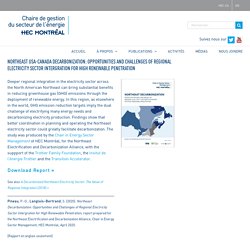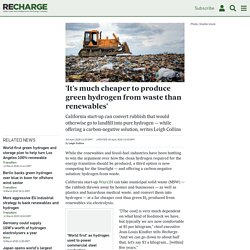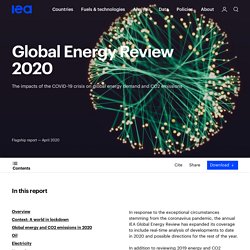

Northeast USA-Canada Decarbonization: Opportunities and Challenges of Regional Electricity Sector Intergration for High Renewable Penetration – Chaire de gestion du secteur de l'énergie. Deeper regional integration in the electricity sector across the North American Northeast can bring substantial benefits in reducing greenhouse gas (GHG) emissions through the deployment of renewable energy.

In this region, as elsewhere in the world, GHG emission reduction targets imply the dual challenge of electrifying many energy needs and decarbonizing electricity production. Findings show that better coordination in planning and operating the Northeast electricity sector could greatly facilitate decarbonization. Gérer et décider dans le secteur de l’énergie. La formation du 7, 8 mai 2020 est reportée au 19, 20 novembre 2020.

Elle sera également donnée en ligne les 7, 8, 14 et 15 mai 2020 de 9 h à 12 h. Si vous désirez plus d’information, vous pouvez contacter Chantal Daigneault. Saisissez les opportunités de la transition énergétique québécoise! Transition Énergétique Québec a lancé son plan directeur de la transition énergétique, et le contexte technologique évolue très vite. Comment devez-vous vous positionner dans cette mise en œuvre de programmes et de mesures pour atteindre des cibles énergétiques déterminées par le gouvernement? Dans ce contexte de changements, prendre un temps de réflexion pour comprendre ce contexte et réfléchir aux options possibles est incontournable pour quiconque veut participer à la transition énergétique et réussir à en sortir gagnant. Ce séminaire permet de faire le point sur ces tendances globales, dans une perspective locale et en tenant compte du contexte législatif propre au Québec. 'It's much cheaper to produce green hydrogen from waste than renewables'
While the renewables and fossil-fuel industries have been battling to win the argument over how the clean hydrogen required for the energy transition should be produced, a third option is now competing for the limelight — and offering a carbon-negative solution: hydrogen from waste.

California start-up Ways2H can take municipal solid waste (MSW) — the rubbish thrown away by homes and businesses — as well as plastics and hazardous medical waste, and convert them into hydrogen — at a far cheaper cost than green H2 produced from renewables via electrolysis. “[The cost] is very much dependent on what kind of feedstock we have, but typically we are now comfortable at $5 per kilogram,” chief executive Jean-Louis Kindler tells Recharge. “And we can go down to about half that, let’s say $3 a kilogram… [within] five years.” “We can supply renewable hydrogen, just like solar and wind-powered electrolysed hydrogen, but without using the vast space that solar panels require,” says Kindler. Global Energy Review 2020 – Analysis - IEA.
The current Covid-19 pandemic is above all a global health crisis.

As of the 28th of April, there were 3 million confirmed cases and over 200 000 deaths due to the illness. As a consequence of the efforts to slow the spread of the virus, the share of energy use that was exposed to containment measures jumped from 5% in mid-March to 50% in mid-April. Several European countries and the United States have announced that they expect to reopen parts of the economy in May, so April may be the hardest hit month. Beyond the immediate impact on health, the current crisis has major implications for global economies, energy use and CO2 emissions.
Renewables Are the Only Winners in Historic Decline in Energy Demand. (Bloomberg) — The coronavirus lockdown will cause the biggest drop in energy demand in history, with only renewables managing to increase output through the crisis.

As people around the world consume less oil, gas and coal, electricity generated from the wind and sun will keep flowing, resulting in an unprecedented 8% decline in global carbon dioxide emissions this year, according to a report from the International Energy Agency. “The energy industry that emerges from this crisis will be significantly different from the one that came before,” Fatih Birol, the IEA’s executive director, said in a statement released from the organization’s headquarters in Paris on Thursday.
The pandemic has infected at least 3 million people worldwide and killed more than 200,000 people as of April 29. With no drug to treat Covid-19 and a vaccine not expected until at least the end of the year, reducing the interactions between infected people is the only effective way to control the spread. Oil Glut. Kelly McParland: Ending hydro subsidies for Ontarians who don't need them could help pay for COVID measures. Reading a document released Tuesday by the Ontario Energy Association , you might think the body representing the province’s energy producers and distributors had left the office and forgot to pack its brain.

The OEA policy statement urges the province to end its practice of heavily subsidizing hydro rates, and replace it with a system of targeted breaks for those who need it most. Great idea, eh? Right in the middle of a global crisis that has shuttered companies, sent unemployment soaring, capsized the economy and turned forecasting the future into a giant game of blind man’s bluff, here comes OEA to propose millions of Ontarians get hit with higher power bills. Good timing folks. But wait. These people haven’t lost control of their senses. Produire de l'énergie renouvelable. Solar and Wind Cheapest Sources of Power in Most of the World. Photographer: Adriano Machado/Bloomberg Solar and onshore wind power are now the cheapest new sources of electricity in at least two-thirds of the world’s population, further threatening the two fossil-fuel stalwarts -- coal and natural gas.

The levelized cost of electricity for onshore wind projects has fallen 9% to $44 a megawatt-hour since the second half of last year. Solar declined 4% to $50 a megawatt-hour, according to a report Tuesday by BloombergNEF. Aux Etats-Unis, 39% du GNV est renouvelable. Le groupe industriel NGV America et l’organisation à but non lucratif RNG Coalition ont annoncé qu’au cours de l’année 2019, 39% de tout le carburant routier au gaz naturel aux USA était du biométhane renouvelable, issu de matières organiques.

Au cours des cinq dernières années, l’utilisation du biométhane comme carburant de transport a augmenté de 291%. Capté en surface à partir de déchets agricoles, d’eaux usées ou de déchets alimentaires, le biométhane produit des résultats neutres en carbone, voire négatifs lorsqu’il alimente des véhicules routiers. « Les véhicules fonctionnant au gaz naturel renouvelable constituent l'option la plus immédiate et la plus rentable pour les poids lourds lorsqu'il s'agit de lutter contre le changement climatique et de purifier l'air », a déclaré Dan Gage, président de NGVAmerica.
L’agrivoltaïsme sort de l’ombre et stimule les rendements agricoles - Révolution Énergétique.